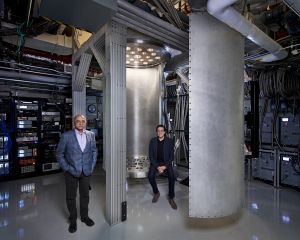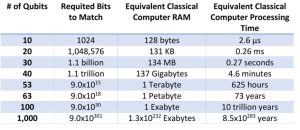Difference between revisions of "Darwin2049/ChatGPT4/PhaseShift"
Darwin2049 (talk | contribs) |
Darwin2049 (talk | contribs) |
||
| Line 70: | Line 70: | ||
'''''<Span Style="COLOR:BLUE; BACKGROUND:SILVER">Phase Shift: Gas, Liquid, Solid.</SPAN>''''' Classical physics describes how states of matter possess different properties depending upon their energy state or environment. Thus on the surface of the earth we can experience the gas of the atmosphere. In environments that are somewhat above the freezing point of water we are unaware of the fact that we inhale and exhale atmospheric gas. It is odorless, colorless and tasteless. <BR /> | '''''<Span Style="COLOR:BLUE; BACKGROUND:SILVER">Phase Shift: Gas, Liquid, Solid.</SPAN>''''' Classical physics describes how states of matter possess different properties depending upon their energy state or environment. Thus on the surface of the earth we can experience the gas of the atmosphere. In environments that are somewhat above the freezing point of water we are unaware of the fact that we inhale and exhale atmospheric gas. It is odorless, colorless and tasteless. <BR /> | ||
* '''''<SPAN STYLE="COLOR:BLUE">Gas.</SPAN>''''' Were we to collect sufficient quantities of atmospheric gas into a sealable container it would be possible to cool the gasses comprising earth's atmosphere into liquids. The idea of wetness, shape conformability and other properties of a liquid would suddenly become evident. Yet it would be difficult to adduce wetness if we never had experience with a liquids.<BR /> | * '''''<SPAN STYLE="COLOR:BLUE">Gas.</SPAN>''''' Were we to collect sufficient quantities of atmospheric gas into a sealable container it would be possible to cool the gasses comprising earth's atmosphere into liquids. The idea of wetness, shape conformability and other properties of a liquid would suddenly become evident. Yet it would be difficult to adduce wetness if we never had experience with a liquids.<BR /> | ||
** Properties. {invisible, odorless, colorless, conformable, insensate}; | |||
** Properties. | |||
* '''''<SPAN STYLE="COLOR:BLUE">Liquid.</SPAN>''''' If one never had contact with the liquid state of H2O then properties as buoyancy, wetness, conformability (i.e. to the shape of a container, evaporation, discoloration and similar properties might be very difficult to imagine. It would be difficult if not even impossible to envision something that was otherwise undetectable because it was odorless, colorless and tasteless could somehow cause one's death by drowning. Yet were one to be plunged into a large enough body of water but not possess swimming skills one could very well die by drowning. <BR /> | * '''''<SPAN STYLE="COLOR:BLUE">Liquid.</SPAN>''''' If one never had contact with the liquid state of H2O then properties as buoyancy, wetness, conformability (i.e. to the shape of a container, evaporation, discoloration and similar properties might be very difficult to imagine. It would be difficult if not even impossible to envision something that was otherwise undetectable because it was odorless, colorless and tasteless could somehow cause one's death by drowning. Yet were one to be plunged into a large enough body of water but not possess swimming skills one could very well die by drowning. <BR /> | ||
** Properties. {wet conformable immersive caloric sensate}; | |||
* '''''<SPAN STYLE="COLOR:BLUE">Solid.</SPAN>''''' The process can be repeated. If we were to use water as a basis then we might discover another state of matter that water can exhibit. This is the state of ice. Many of us use this material (ice) to condition our beverages. That a heretofore wet liquid could become solid might also defy our ability to imagine it taking on solid form. These all consist of the same substance, i.e. H2O. Yet properties found in one state, or phase bear little or no resemblance to those in the subsequent state. We should expect to see an evolution comparable happening in fast forward motion that is very comparable to "gas to liquid, liquid to solid". When DeepMind or CG4 are re-hosted in a quantum computing environment equally unimaginable capabilities will become the norm.<BR /> | * '''''<SPAN STYLE="COLOR:BLUE">Solid.</SPAN>''''' The process can be repeated. If we were to use water as a basis then we might discover another state of matter that water can exhibit. This is the state of ice. Many of us use this material (ice) to condition our beverages. That a heretofore wet liquid could become solid might also defy our ability to imagine it taking on solid form. These all consist of the same substance, i.e. H2O. Yet properties found in one state, or phase bear little or no resemblance to those in the subsequent state. We should expect to see an evolution comparable happening in fast forward motion that is very comparable to "gas to liquid, liquid to solid". When DeepMind or CG4 are re-hosted in a quantum computing environment equally unimaginable capabilities will become the norm.<BR /> | ||
** Properties. {nonconformable textural firmness caloric} | |||
[[File:HadamardSphere.png|300px|right|Hadamard Sphere]] | [[File:HadamardSphere.png|300px|right|Hadamard Sphere]] | ||
[[File:IBMQUANTUM2.jpg|right|300px|Exponential Computational Capabilities]] | [[File:IBMQUANTUM2.jpg|right|300px|Exponential Computational Capabilities]] | ||
Revision as of 00:26, 4 December 2023
Quantum Computing. Quantum computing is currently making its way into the mainstream computing world. Major industrial giants such as IBM, Google and other smaller entrants such as D-Wave are moving forward briskly at ushering this new technology into the light of day.
Recently IBM announced its IBM Quantum System Two which is based upon their 432 qubit Osprey quantum processor. Google has published a timeline of progress stipulating increasing performance milestones through the 2020’s. Some salient points to keep in mind regarding this topic are that:
- Before/After. Quantum computing will be transformative in all areas of human endeavor. Impacts will emerge that are comparable to the taming of fire, animal husbandry, agriculture and writing.
- Cognitive Prosthetic. Increasingly mainstream quantum computing systems will enable dramatic advances in science and technology. Associated advances will emerge in other areas of human endeavor such as politics, sociology, psychology, economics and geopolitics. An tentative model might be a person with a cognitive expansion capability. This might resemble something like an actively directable form of sub consciousness.
- Composite Systems. Typical high end systems today consist of rows of rack mounted processing systems that are networked together for performance purposes. Quantum systems will capitalize on these existing systems. The ability to effortlessly and instantly connect to dedicated high end server farms will mean that some of the most difficult and intractable problems will become amenable to nearly instant solution or otherwise resolution.
- Conformal Cognitive Interfaces. Were a research team to configure an existing deep learning system such that it was optimized to support a rich feature space based upon theory of mind then modification of the Turing Test may require revision in the very near term.
- HAL9000.
- Sphere.
- Geostrategic Imperatives. The national interest security community has forcefully sounded the alarm about the existential importance of seizing the scientific and technological high ground in the area of quantum computing and artificial intelligence. Going forward the race will escalate between the US and the PRC. Calls to slow or pause advances in deep learning systems will be dismissed as hopelessly naïve and shortsighted.
Phase Shift: Gas, Liquid, Solid. Classical physics describes how states of matter possess different properties depending upon their energy state or environment. Thus on the surface of the earth we can experience the gas of the atmosphere. In environments that are somewhat above the freezing point of water we are unaware of the fact that we inhale and exhale atmospheric gas. It is odorless, colorless and tasteless.
- Gas. Were we to collect sufficient quantities of atmospheric gas into a sealable container it would be possible to cool the gasses comprising earth's atmosphere into liquids. The idea of wetness, shape conformability and other properties of a liquid would suddenly become evident. Yet it would be difficult to adduce wetness if we never had experience with a liquids.
- Properties. {invisible, odorless, colorless, conformable, insensate};
- Liquid. If one never had contact with the liquid state of H2O then properties as buoyancy, wetness, conformability (i.e. to the shape of a container, evaporation, discoloration and similar properties might be very difficult to imagine. It would be difficult if not even impossible to envision something that was otherwise undetectable because it was odorless, colorless and tasteless could somehow cause one's death by drowning. Yet were one to be plunged into a large enough body of water but not possess swimming skills one could very well die by drowning.
- Properties. {wet conformable immersive caloric sensate};
- Solid. The process can be repeated. If we were to use water as a basis then we might discover another state of matter that water can exhibit. This is the state of ice. Many of us use this material (ice) to condition our beverages. That a heretofore wet liquid could become solid might also defy our ability to imagine it taking on solid form. These all consist of the same substance, i.e. H2O. Yet properties found in one state, or phase bear little or no resemblance to those in the subsequent state. We should expect to see an evolution comparable happening in fast forward motion that is very comparable to "gas to liquid, liquid to solid". When DeepMind or CG4 are re-hosted in a quantum computing environment equally unimaginable capabilities will become the norm.
- Properties. {nonconformable textural firmness caloric}
Quantum Mechanics. The brief items that follow are deliberately kept brief because a discussion of the mathematics and physics underpinning quantum computing is beyond the scope of this discussion. This is because the topic area obliged a deep understanding and conversance with very advanced mathematics and physics.
Quantum computing mechanisms due to their inherent nature are capable of solving problems that are beyond any current or foreseeable classical computing architecture.
There are various reasons why this is the case. Quantum computing as the name suggests is grounded in the quantum world. Understanding quantum physics requires the most advanced grounding in physics and mathematics. Therefore we provide only a cursory introduction to some of the more basic elements. Additional definitions can be found via the link at the end of this page.
Advanced mathematics is advised for those wishing to further understand the crucial elements of entanglement, coherence, vector spaces or quantum algorithms.
What can be said currently however is that this new computational environment will make possible solution to currently intractable problems soluble within acceptable time frames. The ability to do so will invariably carry with it great promise but also great risk.
- Superposition. Quantum computers are capable of performing calculations that are beyond the scope of classical computing devices. This arises from the quantum reality of superposition. This means that an object at the quantum level has two factors that can be measured: momentum and location. At any instant a quantum system can be in all possible definable states. The act of attempting a measurement will result in the collapse of this superposition state and result in returning a specific value. But this also means that only one factor can be known at the moment of measurement EITHER the position of the object or its momentum - but not both. This arises due to the Heisenberg's Uncertainty Principle.
- Coherence/Decoherence. A crucial factor that conditions the utility of a device operating at the quantum level is noise. Any kind of noise from heat, vibration or cosmic rays can disrupt the extremely delicate processes at the quantum level. Therefore when numbers are presented they are often not well differentiated into qubits that can perform useful computations relative to those that do not. A strategy for dealing with this problem has been to use large numbers of qubits as an error correcting means. Therefore when a quantum device is said to consist of over a thousand qubits then in fact it might have to use 90% of them just for maintaining quantum coherence and entanglement. In order to get meaningful results these quantum states must be maintained for the duration of the calculation. But at these levels and using this means the result is that calculations happen at scales far beyond merely electronic or even photonic speed but due to quantum realities multiple evaluations can happen in parallel. The result has been the dramatic speed up numbers that have recently been reported in various research labs and corporations. Therefore a quantum computer that is claiming to have one hundred or more coherent qubit capability means that they can outperform classical computers by very wide margins.
- Entanglement.
- Wave-Particle Duality.
- Heisenberg's Uncertainty Principle. Werner Heisenberg was the developer of the now famous Heisenberg Uncertainty Principle and won the Nobel prize for his discovery in 1927. His principle essentially stated that at the micro level of reality (i.e. atomic or subatomic) one can only measure the position OR the momentum of a particle. But because of the particle/wave duality nature of all matter it is impossible to measure both. Should we attempt to pinpoint the location of a particle we might discover its precise point at a specific moment in time but we can NOT know its momentum. Conversely we might measure its momentum or energy state but we can NOT know its position. The reality of the world at the quantum level is inherently counterintuitive. However innumerable physics experiments have demonstrated beyond doubt that this is the reality in which all material objects exist.
The interested observer can find a number of useful references addressing the topics of quantum bits, entanglement and superposition
In some cases they will prove to be fairly technical.






